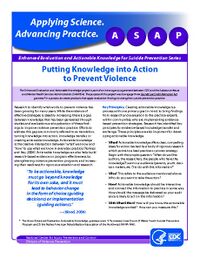Putting Suicide Prevention into Practice by Using Actionable Knowledge
The CDC announces the creation of new suicide prevention products and tools, developed from federal and local partnerships.
For youth between the ages of 10 and 24, suicide is the third leading cause of death. Nearly 14 percent of high school students report seriously considering suicide – which equals three students in an average classroom size of 20. Research also shows the estimated cost of youth suicide to be more than $6 billion a year in medical costs and work loss, in this country alone.
An important step in preventing suicide is ensuring people have access to the best available knowledge and tools to prevent suicide. Equally important is to make certain this information is also actionable, so it can be put into practice.
Suicide Prevention Tools
· Gatekeeper Training Implementation Support System (GTISS)
Created by the Tennessee Lives Count initiative, this is an online resource that provides tools to support successful selection, implementation, and evaluation of gatekeeper training programs.
· Family Brochure
The Native American Rehabilitation Association’s Life is Sacred Native Youth Suicide Prevention Program is built upon the unique role culture plays in prevention of youth suicide.
· MYSPP Early Identification and Referral Data Toolkit
The Maine Youth Suicide Prevention Program (MYSPP) developed an online resource that provides guidance and actionable tools for collecting early identification and referral data on students at risk for suicidal behavior in schools.
Suicide Prevention Research
Through this collaboration, DVP created a series of actionable knowledge briefs to help integrate research into suicide prevention efforts in local communities:
· Putting Knowledge into Action to Prevent Violence
Details on the actionable knowledge process and how communities can put science into action to prevent suicide and other forms of violence.
· Suicide Prevention: A Public Health Issue
Why suicide is a public health issue and the unique role that public health plays in preventing suicide in communities.
· Preventing Suicide Through Connectedness
How connectedness between individuals, families, and organizations can help prevent suicide and increase well-being.







